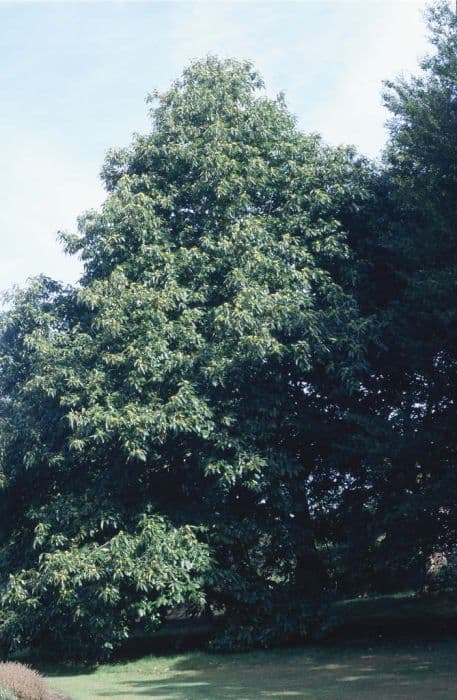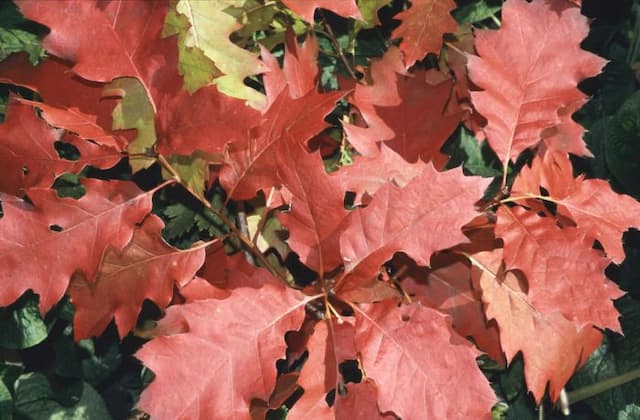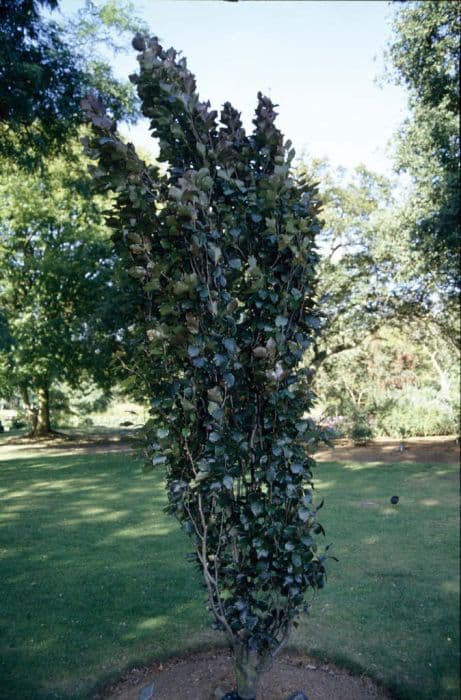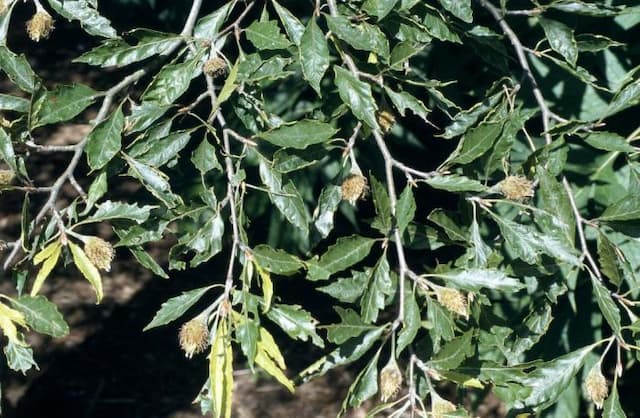Shumard oak Quercus shumardii



ABOUT
Quercus shumardii, also known as Shumard oak or Spotted oak, is a large deciduous tree that can reach up to 80 feet tall in the wild.
It has a rounded, symmetrical crown and a straight trunk with a thick, furrowed bark that is dark gray to black in color.
The leaves are alternate, simple, and lobed with 5-7 lobes per leaf. The lobes are rounded with a sharp tip and a toothed margin. The leaves are glossy green on top and a lighter green on the bottom.
The acorns are large, typically 1-2 inches long and are enclosed in a thick, scaly cup. They mature in the fall and are a food source for wildlife.
The tree has a distinctive bark that is dark gray to black in color and has deep furrows.
About this plant
 Names
NamesFamily
Fagaceae
Synonyms
Spotted oak, Schneck oak, Shumard red oak, Swamp red oak
Common names
Quercus schneckii Britton
 Toxicity
ToxicityTo humans
Quercus shumardii is not known to be toxic to humans.
However, like with any plants, it's always best to exercise caution and avoid ingesting any parts of the plant, especially if you are not sure of its safety.To pets
Quercus shumardii is not known to be toxic to animals. Its acorns are a food source for wildlife, but it's always best to consult with experts or conduct research if you have specific concerns about an animal's diet.
 Characteristics
CharacteristicsLife cycle
Perennials
Foliage type
Deciduous
Color of leaves
Green and yellow in the fall
Flower color
Green
Height
Up to 80 feet
Spread
Up to 80 feet
Plant type
Tree
Hardiness zones
4
Native area
North America
Benefits
 General Benefits
General BenefitsThe tree provides food and shelter for a variety of wildlife, including squirrels, deer, turkey, and other animals that feed on its acorns;
The tree's deep root system helps to control erosion and improve soil stability, making it a valuable tree for landscaping on slopes or near waterways;
The tree provides shade and cooling, making it a valuable addition to urban landscapes;
The tree's symmetrical crown and distinctive bark make it an attractive addition to any landscape;
Quercus shumardii is a hardy tree that can tolerate a wide range of soil types and growing conditions;
The tree is long-lived, living up to several centuries, making it a valuable investment for the long-term.
Interesting Facts
 Plant Symbolism
Plant SymbolismOak has long been a symbol of strength, morale, resistance, and knowledge.
From ancient mythologies to modern-day, the Oak has been associated with powerful gods and nature. Its ever-lasting presence throughout history is a testament to its power and importance.
The Oak stands tall and proud, a reminder of our resilience, courage, and determination.
 Water
WaterIn the first year after planting, water Quercus shumardii deeply once a week during dry periods.
Once the tree is established, it can typically survive on rainfall alone, but may benefit from occasional deep watering during prolonged dry spells. Light
LightQuercus shumardii thrives in full sun, but can also tolerate partial shade.
 Temperature
Temperaturet can survive temperatures as low as -10°F and higher.
It can adapt to a range of temperatures and can tolerate cold temperatures and occasional frost, but is not tolerant of high heat and humidity. Pruning
PruningPrune Quercus shumardii when it is dormant in the late winter or early spring. Remove dead, diseased, or damaged branches. Thin out the canopy to increase sunlight penetration and air circulation. Prune branches that are rubbing against each other.
 Soil
SoilQuercus shumardii prefers well-drained, fertile soils with a pH between 6 and 7.5, it is tolerant of a wide range of soils, but does not tolerate poorly drained or wet soils.
 Humidity & Misting
Humidity & MistingQuercus shumardii prefers moderate humidity, and it can tolerate a range of humidity levels as long as the soil is well-drained.
But the tree does not stand too hign or too low humidity level around. Suitable locations
Suitable locationsIndoor
Not growing
Outdoor
When planting Quercus shumardii outdoors, choose a site that has well-drained soil and full sun.
Dig a hole that is twice as wide and just as deep as the root ball. Remove the tree from the container and gently loosen the roots before planting.
Space multiple trees at least 30 feet apart.
Water well after planting and keep the soil consistently moist until the tree is established.Hardiness zone
USDA 5 - 10
 Life cycle
Life cycleThe life of the lree begins with germination. Quercus shumardii acorns germinate in the fall or spring after they have been shed from the tree. Germination rates vary depending on the acorn crop and the weather conditions, but are typically high.
Once germinated, Quercus shumardii seedlings grow rapidly and can reach several feet in height in their first growing season. They are able to tolerate some shade, but also need direct sunlight to grow well.
The juvenile phase of Quercus shumardii lasts for several years, during which the tree will develop a straight stem and a well-defined crown.
At maturity, Quercus shumardii can reach a height of 80 feet and a diameter of 3-4 feet. The bark will turn dark and furrowed, and the leaves will be dark green and glossy.
Quercus shumardii will begin to produce acorns when it is around 20-25 years old. The acorns are large, typically measuring 1-1.5 inches in length, and are an important food source for wildlife.
Quercus shumardii can live for several centuries, but as it ages it may become less vigorous and more susceptible to disease and pests. Eventually, the tree will die and decompose, providing nutrients for the next generation of plants. Propogation
PropogationPropogation time
Spring - summer
By SEEDS:
The most common and easiest method of propagating Quercus shumardii is by planting acorns. They can be collected in the fall, stratified (stored in a cool and moist place) for a few months before planting them in the spring, in well-draining soil, in a sunny location.
By GRAFTING:
Grafting involves taking a cutting from a mature Quercus shumardii and attaching it to the rootstock of another tree. This method is more difficult and less common but is useful for reproducing specific genetic traits of a tree.
By LYERING:
Layering is another method of propagation that involves bending a low-hanging branch of the tree to the ground and covering it with soil. Once the branch has rooted, it can be cut from the parent tree and transplanted to a new location.
 Pests
PestsGypsy moth, Oak worm, Oak twig pruner, Oak bark beetle
 Diseases
DiseasesAnthracnose, Root Rot, Canker, Oak wilt, Oak decline









